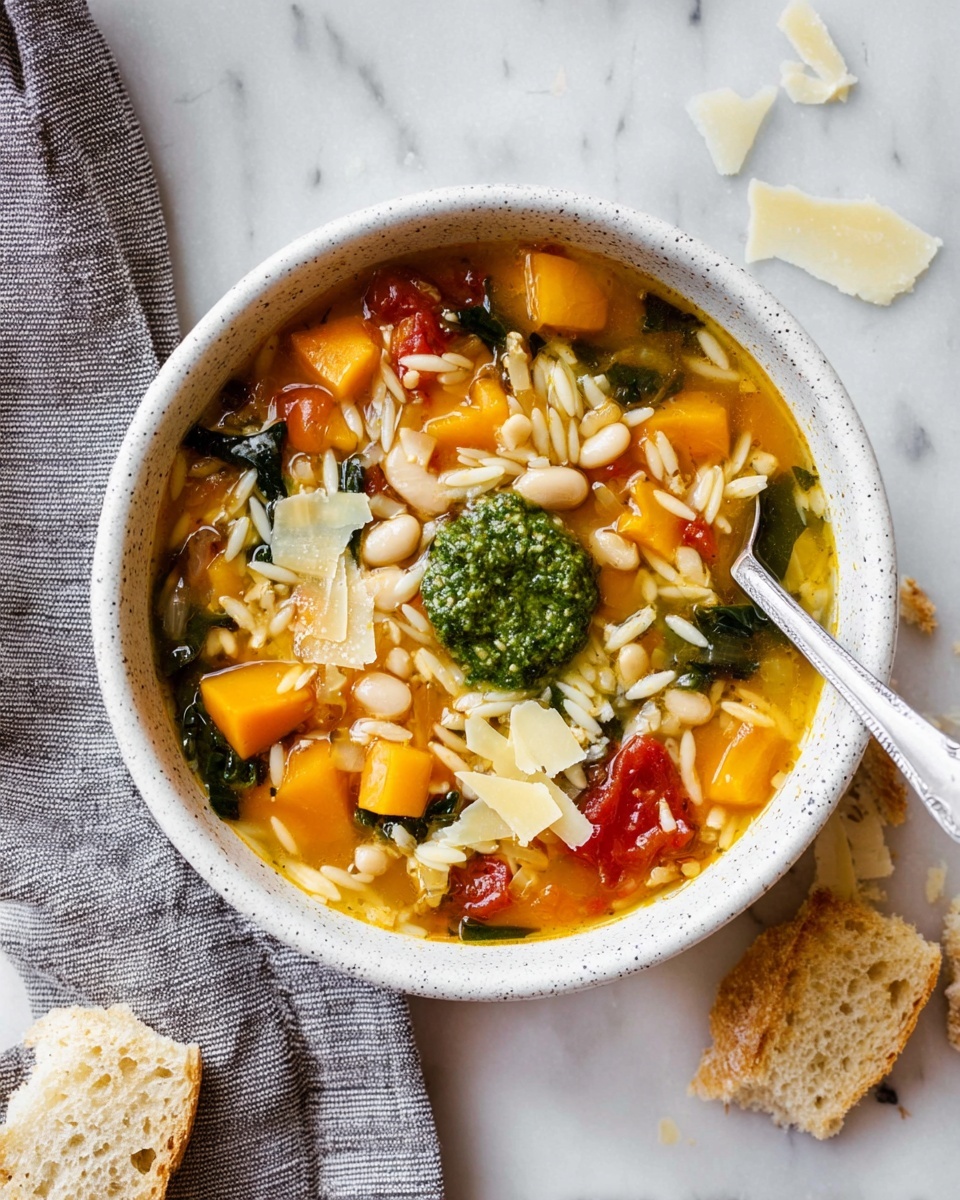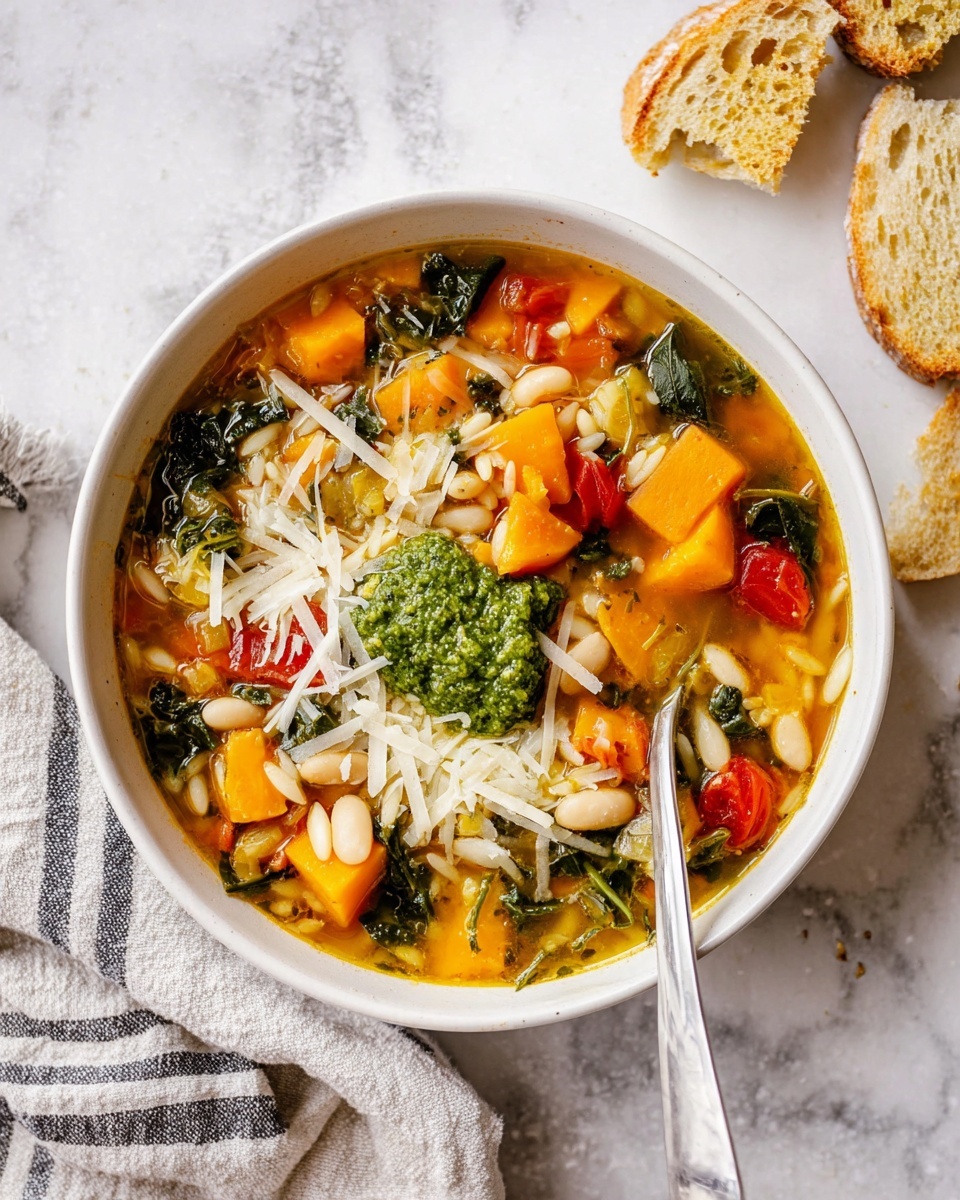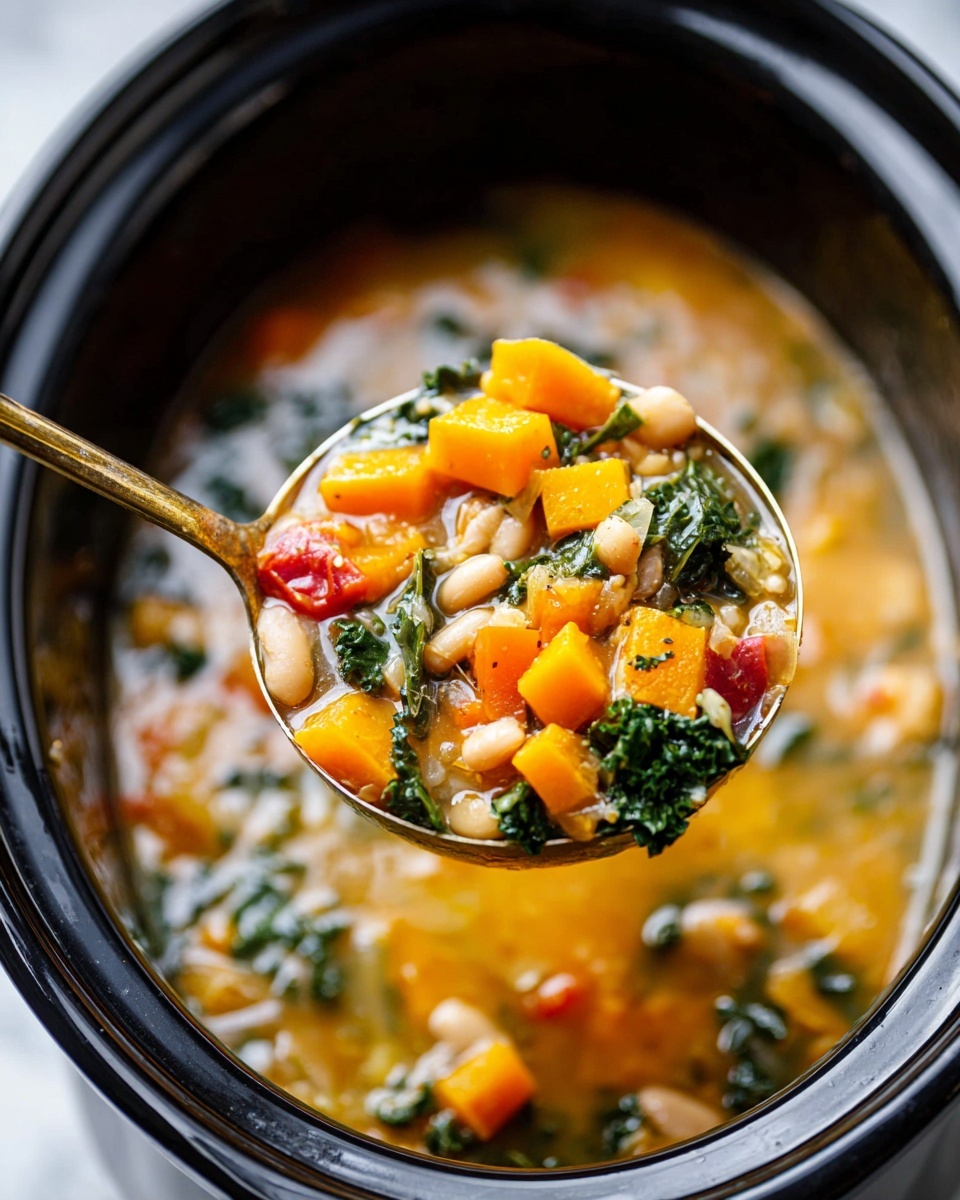If you’re craving something warm, comforting, and packed with cozy winter vibes, this Winter Minestrone Recipe is exactly what you need. I absolutely love how this soup brings together hearty butternut squash, tender beans, and fresh greens in a broth that feels like a big, warm hug. Whether you’re easing into a chilly evening or looking for a nourishing meal that’ll satisfy the whole family, stick around — this recipe is fan-freaking-tastic and surprisingly simple to make.
Why You’ll Love This Recipe
- Hearty and Satisfying: The butternut squash and beans deliver a comforting texture and flavor that feels like a full meal in a bowl.
- Simple Ingredients: You probably have most of these pantry staples on hand, making it a go-to soup for busy nights.
- Versatile and Customizable: You can switch up the greens, beans, or pasta based on what you have or like.
- Full of Nutrients: It’s packed with fiber, plant protein, and vitamins to nourish you through cold winter months.
Ingredients You’ll Need
The beauty of this Winter Minestrone Recipe is in how well these simple ingredients come together. Each item plays its part — lovely sweetness from the butternut squash, hearty beans for protein, and fresh greens to brighten it up. When shopping, look for bright, firm squash and fresh kale or spinach for the best flavor and texture.
- Butternut squash: Choose a firm, evenly colored squash; cubing it small ensures it cooks through perfectly without mushiness.
- Yellow onion: A sweet yellow onion provides a mellow foundation—remember to finely chop for even cooking.
- Garlic: Fresh, minced garlic adds just the right amount of zing—don’t skip it!
- Chickpeas: Canned chickpeas are a quick shortcut, just rinse them well to cut any canning flavor.
- Great Northern beans: Or cannellini beans work beautifully here—white beans bring creaminess and substance.
- Diced tomatoes: Use canned diced tomatoes with their juices for depth and a touch of tanginess.
- Vegetable stock: A rich, quality vegetable stock is the soul of your soup—feel free to use homemade or store-bought.
- Water: Just enough to balance the liquid without diluting the flavors.
- Kosher salt: Season generously—this is how you bring all components to life.
- Italian seasoning: Keep it simple and cozy with no-salt seasoning to control sodium.
- Lacinato kale: Also called dinosaur kale, it holds up wonderfully during cooking without getting mushy; baby spinach works if you prefer.
- Red wine vinegar: Just a splash at the end brightens the whole soup with a gentle acidity.
- Cooked small pasta: I love orzo or ditalini here—gluten-free pasta works just as well.
- Pesto: Optional, but a spoonful stirred in at serving makes a gourmet touch.
- Freshly grated parmesan cheese: A finishing sprinkle adds richness and depth—totally worth it.
Variations
I love to keep this Winter Minestrone Recipe flexible, depending on mood or what’s in my fridge. It’s easy to swap ingredients and still end up with something deliciously hearty.
- Vegetable swaps: Sometimes I use Swiss chard instead of kale, or add diced carrots for a sweeter crunch—it’s all up to you!
- Protein boosts: Adding cooked sausage or shredded chicken turns this into a more robust meal that my family goes crazy for.
- Gluten-free: I always use gluten-free pasta when cooking for friends with sensitivities, and it holds up just as well.
- Spice it up: A pinch of red pepper flakes or a dash of smoked paprika adds a nice warming kick on extra cold nights.
How to Make Winter Minestrone Recipe
Step 1: Sauté Your Aromatics
Start by gently cooking your finely chopped yellow onion in a splash of olive oil over medium heat until it’s soft and translucent — about 5 minutes. Then add the minced garlic and cook for another minute until fragrant. This base layer is key; it sets a lovely savory tone without overpowering the squash’s gentle flavor.
Step 2: Add Butternut Squash and Liquids
Next, toss in your cubed butternut squash along with the canned diced tomatoes (with juices), drained beans, and chickpeas. Pour in the vegetable stock and water, and stir in the kosher salt and Italian seasoning. Bring everything to a gentle simmer. I like to cover the pot and let it cook low and slow for about 50-60 minutes until the squash is tender but not falling apart. This slow cook time allows the flavors to blend beautifully.
Step 3: Add Greens and Pasta
Once the squash is soft, stir in your chopped kale (or spinach) and cooked pasta. Let it simmer a few more minutes so the greens wilt and the pasta warms through. If you’re making this ahead, I usually add the pasta right before serving to keep it from soaking up too much broth and getting mushy.
Step 4: Finish with Vinegar and Serve
Turn off the heat and swirl in a tablespoon of red wine vinegar—this little acid trick is a game-changer for brightening the whole soup. Ladle into bowls, and if you want to get fancy, stir in a spoonful of pesto and sprinkle freshly grated parmesan cheese on top. Trust me, it elevates this humble soup into something special.
Pro Tips for Making Winter Minestrone Recipe
- Low and Slow Simmer: Cooking the soup gently really lets the butternut squash develop a natural sweetness without turning to mush.
- Add Pasta Late: Adding pasta at the very end keeps it from overcooking and absorbing all your broth.
- Brighten with Vinegar: A splash of red wine vinegar right before serving lifts all the flavors—don’t skip this!
- Rinse Your Beans: Rinsing canned beans cuts down on excess salt and improves their texture in the soup.
How to Serve Winter Minestrone Recipe

Garnishes
I love topping my Winter Minestrone with a generous sprinkle of freshly grated parmesan cheese—it melts just enough to add a creamy bite. A dollop of pesto swirled in at the last second is a personal favorite, adding that herby pop and richness. Sometimes, a handful of toasted pine nuts or fresh basil leaves takes it over the top for company dinners.
Side Dishes
This soup shines as a standalone meal, but if you’re feeling extra hungry, crusty bread or a warm garlic baguette always pairs perfectly. I also like a simple mixed green salad dressed in a tangy vinaigrette, which cuts through the richness of the soup nicely.
Creative Ways to Present
For a cozy dinner party, serve this Winter Minestrone Recipe in rustic, shallow bowls with a small spoonful of pesto and parmesan stacked neatly on top. You can even hollow out small loaves of sourdough bread and ladle the soup inside for a charming edible bowl that’s sure to impress your guests.
Make Ahead and Storage
Storing Leftovers
I store leftover Winter Minestrone in airtight containers in the refrigerator for up to 4 days. I keep the pasta separate if I know it won’t be eaten within a day, otherwise it can get a little mushy after sitting. Reheating gently on the stove with a splash of broth or water helps bring it back to life.
Freezing
Freezing this soup works wonderfully; I usually leave out the pasta before freezing and add fresh cooked pasta when reheating. Freeze in portion-sized containers and thaw in the fridge overnight for best results. This way, you have a quick, nourishing meal ready on a busy winter evening.
Reheating
To reheat, warm gently over low heat on the stovetop to avoid overcooking the greens and pasta. Stir frequently and add a splash of broth to loosen if needed. I like to add a little extra fresh herbs or a drizzle of olive oil at this stage to refresh the flavors.
FAQs
-
Can I make this Winter Minestrone Recipe vegan?
Absolutely! Just skip the parmesan cheese or use a vegan alternative, and avoid any pesto that contains cheese, or make your own vegan pesto at home. The soup itself is naturally plant-based and delicious without any animal products.
-
What pasta works best in Winter Minestrone Recipe?
Small-shaped pasta like orzo, ditalini, tubetti, or elbow macaroni work beautifully because they mingle well with the veggies and broth. If you need gluten-free, use your favorite gluten-free small pasta and cook it just until al dente to prevent mushiness.
-
How long can I store leftover Winter Minestrone?
You can keep leftovers in the refrigerator for up to 4 days. For longer storage, freeze in airtight containers for up to 3 months. Remember to keep pasta separate if possible to maintain the best texture.
-
Can I substitute other greens for kale?
Yes! Baby spinach, Swiss chard, or even collard greens can be used instead of kale. Just add them towards the end of cooking since they wilt quickly.
Final Thoughts
This Winter Minestrone Recipe holds a special place in my kitchen for its simplicity and soul-warming qualities. I used to struggle to find a soup recipe that felt both nourishing and satisfying without being complicated, and this one nails it every time. I hope you enjoy making it as much as I do — it’s perfect for sharing over cozy dinners or just treating yourself after a chilly day. Go ahead, cozy up with a bowl — you deserve it!
Print
Winter Minestrone Recipe
- Prep Time: 10 minutes
- Cook Time: 360 minutes
- Total Time: 370 minutes
- Yield: 8 servings 1x
- Category: Soup
- Method: Stovetop
- Cuisine: Italian
- Diet: Vegetarian
Description
This Winter Minestrone is a hearty and nourishing vegetarian soup perfect for cold weather. Combining cubed butternut squash, beans, kale, pasta, and a medley of flavorful seasonings in a vegetable stock base, it offers comforting warmth and a satisfying blend of textures and flavors. Finished with a splash of red wine vinegar, pesto, and a sprinkle of Parmesan cheese, it’s an easy-to-make, cozy dish ideal for a wholesome dinner.
Ingredients
Main Ingredients
- 4 cups cubed butternut squash
- 1 medium yellow onion, finely chopped
- 2 cloves garlic, minced
- 1 (15-oz) can chickpeas, drained and rinsed
- 1 (15-oz) can Great Northern beans (or any white bean such as cannellini), drained and rinsed
- 1 (15-oz) can diced tomatoes
- 1 quart vegetable stock
- 2 cups water
- 3 teaspoons kosher salt
- 1 teaspoon no-salt added Italian seasoning
- 1 cup chopped Lacinato kale (or baby spinach)
- 1 tablespoon red wine vinegar
- 1 cup cooked small shape pasta (such as orzo, ditalini, tubetini, or elbow macaroni; use gluten free pasta for gluten free)
For Serving
- Pesto
- Freshly grated Parmesan cheese
Instructions
- Prepare the vegetables: Peel and cube the butternut squash into 1-inch pieces, finely chop the yellow onion, and mince the garlic cloves to have all the fresh ingredients ready.
- Sauté aromatics: In a large pot, warm a small amount of oil over medium heat. Add the chopped onion and garlic and sauté until fragrant and translucent, about 3-5 minutes.
- Add main ingredients: Stir in the cubed butternut squash, drained chickpeas, Great Northern beans, and diced tomatoes. Mix well to combine all ingredients evenly.
- Add liquids and seasonings: Pour in the vegetable stock and water. Stir in kosher salt and no-salt added Italian seasoning. Bring the mixture to a boil over high heat.
- Simmer the soup: Reduce the heat to low and let the soup simmer gently for approximately 6 hours (360 minutes), uncovered or partially covered, allowing flavors to deepen and the squash to become tender.
- Cook the pasta: About 10 minutes before serving, add the cooked small shape pasta into the soup to heat through and absorb flavors.
- Add greens and finish: Stir in the chopped Lacinato kale or baby spinach and let it wilt in the hot soup. Remove from heat and stir in the red wine vinegar for a touch of acidity.
- Serve: Ladle the soup into bowls and top with a dollop of pesto and a generous sprinkle of freshly grated Parmesan cheese for extra flavor and richness.
Notes
- This vegetarian winter minestrone is a delicious and nourishing soup that’s easy to prepare and full of comforting flavors perfect for cold weather.
- Use gluten-free pasta if you need the recipe to be gluten free.
- Leftovers can be stored in the refrigerator for up to 4 days and taste even better as flavors meld.
- The long simmering time ensures a rich depth of flavor and tender vegetables, but you can shorten by pre-cooking the squash and reducing simmer time modestly if needed.
- Add pesto and Parmesan last to keep their fresh flavors intact.
Nutrition
- Serving Size: 1 bowl (approximately 1/8 of recipe)
- Calories: 285 kcal
- Sugar: 3 g
- Sodium: 481 mg
- Fat: 0.4 g
- Saturated Fat: 0.1 g
- Unsaturated Fat: 0.14 g
- Trans Fat: 0 g
- Carbohydrates: 19 g
- Fiber: 3 g
- Protein: 3 g
- Cholesterol: 0 mg



